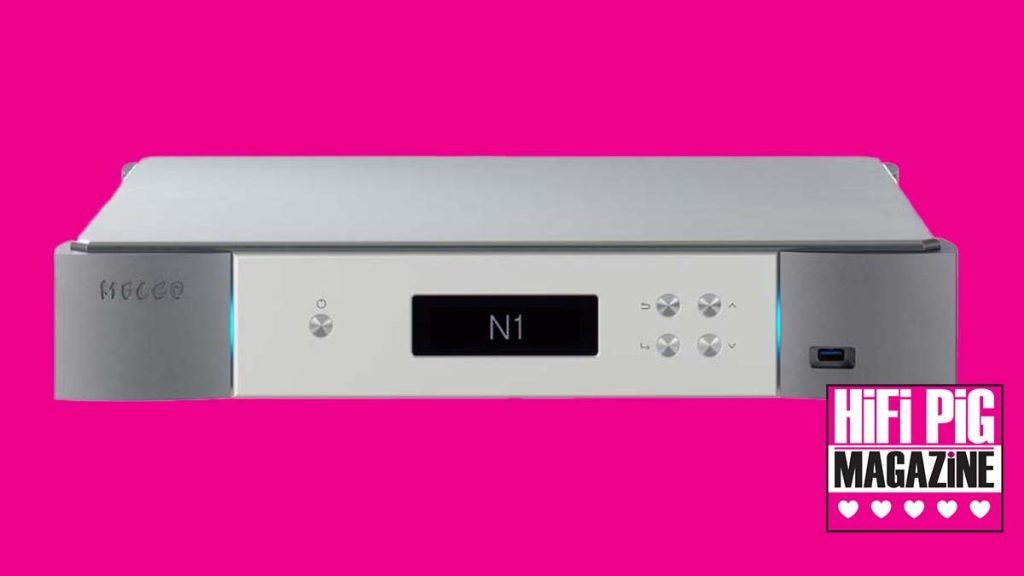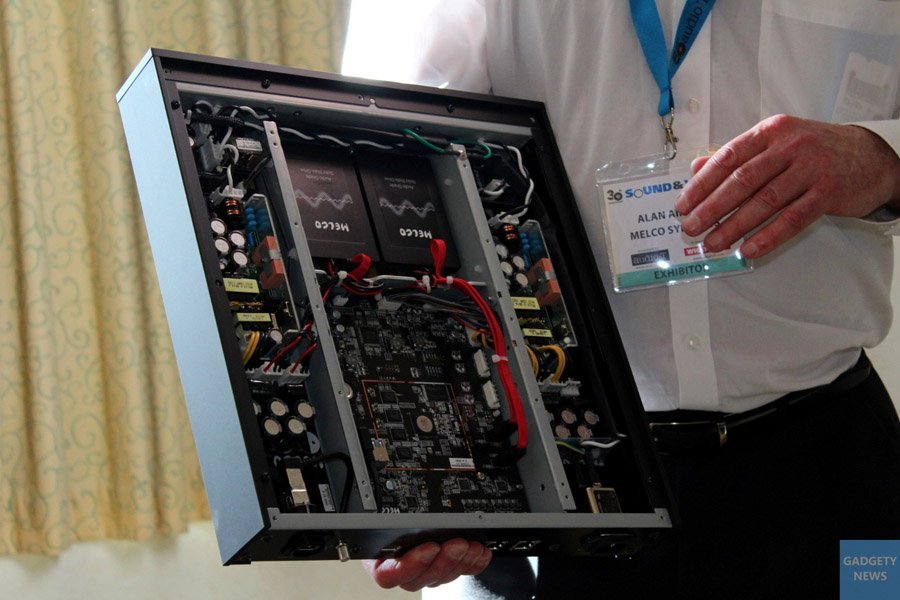MELCO N1-S38 REVIEW
In his Melco N1-S38 review, Chris Baillie takes a listen to the latest flagship server costing almost £12,000. Is it worth this not inconsiderable outlay?
The Melco name has become synonymous with high-quality audiophile music servers since first introducing their ground-breaking N1A and N1Z models eight or nine years ago. Surprisingly the brand, which hails from Nagoya in Japan, entered the audio world as a manufacturer of high-mass turntables with outboard motors. The company also produced some pre-amplifiers but then moved into the electronics world through Buffalo Electronics, which became a global networking and storage solutions provider. Indeed the name ‘Buffalo’ comes from the brand’s success as a pioneering designer and manufacturer of printer buffers.
Whilst audiophiles in many parts of the world embraced computers in their listening rooms a couple of decades ago, the Japanese were reluctant to do so. It is no coincidence that Japan still has a large market for SACD and audiophile CD releases. The inception of the Melco range of servers came by way of providing this market with a network audio solution, which was not a computer. Following the company’s initial success with audio servers, they have enjoyed great success with their range of audiophile switches, which have inspired many imitators.
The N1-S38 here was released around the time of the Bristol Hi-Fi Show in February. I was lucky to hear and see one at the show, albeit in an unfamiliar system. At £11,995, it became the most expensive product the brand has produced so far.
BUILD, DESIGN, AND FEATURES OF THE MELCO N1-S38
The ‘S38’ moniker refers to the server’s 3.84TB solid-state hard drive (SSD). SSDs are inherently electrically noisier than HDDs (hard drives), but Melco solves this issue by controlling the unit’s SSD with a secondary power supply. Indeed further secondary power supplies feed all critical components on the main board. The N1’s main power supply is what Melco describe as a ‘massive’ LPSU. The main board is brand new and contains many high-grade electrical components to reduce jitter-inducing noise. The CPU is unchanged from the rest of the range – one of the reasons Melco claim its products sound as good as they do, is that everything runs ‘just’ fast enough to do its job, therefore avoiding additional electrical noise. The internal Flash Memory module capacity has been increased. The N1-S38 and its lower-priced sister model, the N5-H50, have SFP (small form-factor pluggable), otherwise known as fibre optic inputs. Melco’s S100 and S10 data switches have such outputs, allowing an electrically galvanised connection.
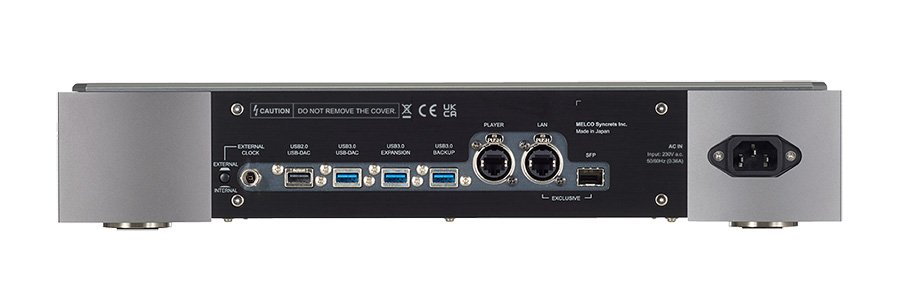
The new Melco N1-S38 from the rear
A product at this price level should make a visual and physical impression. The N1-S38 thankfully delivers on both fronts. As an owner and user of Sim Audio Moon electronics, I could not help but notice the visual resemblance. The unit is reassuringly heavy; you can blame that ‘massive’ linear PSU for a large proportion, along with the 5mm thick aluminium casing panels. Whereas my own NA1/2 looks and feels ‘functional’, the N1-S38’s build and design suggest it’s every bit the range-topper that it is. I have heard complaints that the unit lacks the clearance at the bottom of its chassis for fingers, therefore pinching them as the unit is lowered onto a supporting surface. As I slid my review unit onto one of the middle shelves of my rack, my fingers remained unharmed, but I do get their point. The N1-S38 is fitted with vibration-damping feet, so I did not experiment with after-market options, especially as raising the height may have meant the top of the unit was too close to the shelf above.
The rear of the unit extends the impression of quality and solidity. As with the lower models in the range, you have an Ethernet input and output; the latter is referred to as ‘Player Port’ in Melco Speak. Both of these sockets are rock-solid. There is also a dedicated USB 2.0 output, which Melco feel sounds better than USB 3.0 – lower speeds mean potentially (claimed) lower noise. A secondary USB 3.0 output will feed a DAC, or accept the input from a USB CD ripping drive, such as the Melco D100, or perhaps a USB stick or HDD for music file input. There is a USB input for an expansion drive, with the final USB socket being for the backup drive. There is also a socket for connecting an external clock and a switch to toggle between the internal and an external clock. Finally, there is the SFP input.
At the front of the unit, there is a USB socket, primarily for plugging in a USB stick for importing or playing music, but like the rear port, you can also connect a CD drive. You can now plug a remote reading ‘stick’ into the front (or rear) USB port, allowing users to control the server via remote control. The front display and controls will be familiar to existing Melco users, although the buttons feel nicer to use here.
The operating system will be familiar to existing users of the ‘EX’ range of Melco components. I wrote a piece on this for HiFi Pig back in February 2021, which was a few months after EX range was launched, so I won’t spend too long talking about this. It does mean the N1-S38 is fully Roon compatible, although unfortunately, I am not a Roon user, so I could not test this feature. The EX upgrades also saw the introduction of Minimserver 2 and Songkong being installed on the machine; again, please refer to the previous article for more info. Melco has its own UPnP App, which is essentially a tailored version of Mconnect. It is only available in IOS, i.e. for Apple. Although I briefly tested the review unit with Bubble UPnP, Mconnect and the Moon MiND App, I primarily used it with the excellent JPlay UPnP App via an ageing iPad.
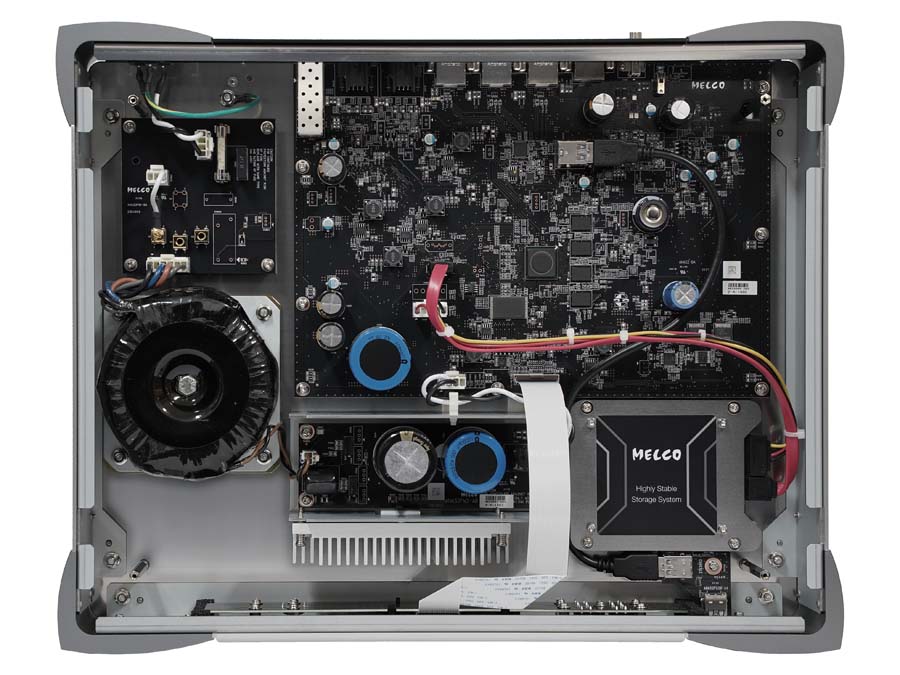
A look inside the Melco
While the N1-S38 came ‘loaded’ with various music, I imported my own library via a backup drive from my personal NA1/2. As the Melco performs its ‘house-keeping’ duties at a low speed, importing my collection took an agonising two days. This is not a job you are likely to perform often though, and the unit can still stream from cloud services or even internet radio whilst it is busy importing. The N1-S38 showed up on my network via UPnP Apps and Windows Explorer without hesitation, which was reassuring. The only slight issue I had was that the USB output initially was not showing up as an output option, but a scan through the menu revealed it was set to work with Roon rather than UPnP, so this was quickly rectified.
SOUND OF THE MELCO N1-S38
All testing was carried out in my main system, which consists of a Melco S100 Network Switch fed via an ADOT Fibre Optic converter. My DAC/Streamer is the Moon 780D, which feeds a Moon 600i amplifier. All analogue cables are from Townshend Audio; the speakers are Totem Forest Signatures. I still use the excellent ENO Ethernet cable and filter from Network Acoustics which I tested for ‘Pig in January last year, to connect the Melco the 780D. The USB cable used was the CAD Audio USB-11R. Mains cables are a mixture of Chord Co and Russ Andrews, fed via the Chord Co PowerHAUS M6 mains block, which I reviewed for HiFi Pig in February.
Initially, I hooked up the N1-S38 in a similar configuration to my older unit, with a high-quality Ethernet cable feeding it from the S100 switch. After a couple of days, I replaced the Ethernet cable with an SFP fibre optic cable, which produced such an improvement that I left it connected that way.
Whilst, like all reviewers, I do have certain go-to test tracks, I mostly start by playing something I have had on recent rotation to get a feel of what the review product is doing. In this case, the music was a rip of the recently released Analogue Productions SACD of Steely Dan’s Countdown To Ecstasy. It was immediately apparent that the music sounded cleaner and instruments were better separated compared to how it sounded via my older unit. As the album progressed, I noted guitars had more body and detail. Dating back to 1973, some tracks on this album sound more compressed than others, but the N1-S38 seemed to dig out more of the good stuff than my N1A/2. So a good first impression, but at this point, my jaw had not fully hit the floor. Next up was the 24/192 version of Cat Stevens’ Tea For The Tillerman, which left me catching flies for several seconds. Deep down, I would describe myself as a fully committed digital guy who feels that the most involving reproduction comes from analogue sources. Listening to the N1 playing Tea For The Tillerman had me doubting this last point; so captivating was the performance it delivered. My notes say things like ‘vocal detail’, ‘realistic instrumental timbre’, ‘dynamic range’ etc., but this sounded like wonderful music.
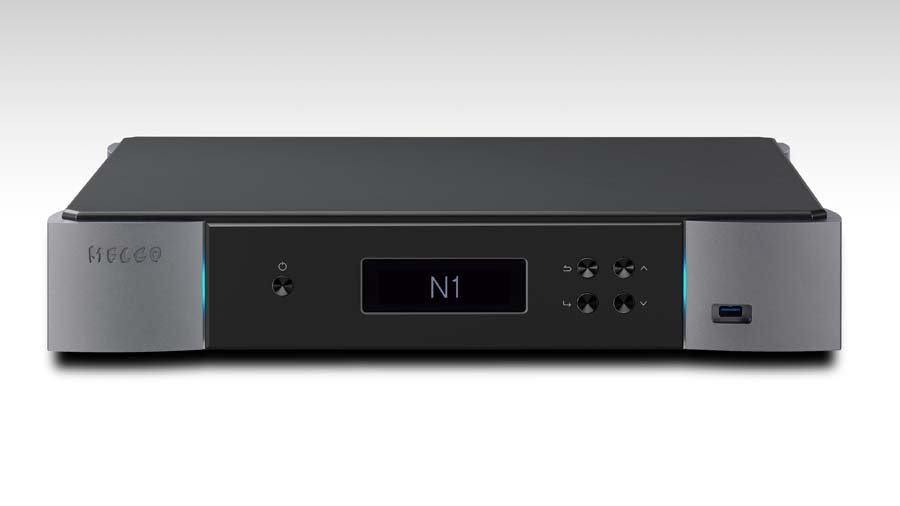
Also available in black
You will often read reviewers raving about how great the timing is of a given product, but the N1-S38 floored me with how it revealed how singers such as Joni Mitchell and PJ Harvey play around how they time certain phrases. Playing the latest album from the latter, I Inside The Old I Dying (24/96 Qobuz download), you can hear Polly singing on and off the beat, particularly on the album’s first track, Prayer At The Gate. This album is not what you would classify as an Audiophile production, but via the N1, it became a musically compelling one.
I had previously found my own Melco unit, whilst sounding more detailed via USB, especially since I began using the CAD USB-11R, generally sounds more rounded, spacious and musically satisfying via the Ethernet output. Once I had worked out how to switch the N1-S38 from Roon to USB mode and compared the two, it was apparent the latter sounded better. Having discovered this, I decided to use the N1-S38 to stream from Qobuz and listen via the USB output to my Moon 780D, which does have a high-quality MiND 2 streamer built-in.
First up was Joni Mitchell’s new live album Live At Newport, in 24/192, which produced another ‘wow moment’. Short of being at the gig itself, I cannot imagine this sounding more intimate and emotionally involved. The N1-S38 revealed a great sense of interplay between singers and musicians, which was stunning. I next streamed Coyote from her Hejira album via Qobuz in 24/192, which was reproduced to the highest standard I had so far experienced. Via my older machine, even my locally stored version often sounded somewhat shut-in and restrained in comparison. Here Joni’s vocals were reproduced in a solid central location, but the guitars and acoustic bass now sounded so natural and open I found it hard to believe it was the same track. Best of all was the insight into Joni’s vocal performance, revealed in a new light by the N1-S38. So low was the noise floor I could now hear how her words were formed and appreciate the pauses between them. Comparing the Qobuz stream of Hejira to the version I had copied to the N1-S38’s SSD initially confused me, as it sounded slightly less spacious and open. I then realised my stored version was in 24/96, which explained things, but I was still impressed that the ‘cloud streamed’ version sounded better, demonstrating the N1-S38’s abilities when streaming from external services. Until a few months ago, it may have been worth mentioning that this machine does not decode Tidal MQA files, but I feel that this is no longer so relevant as Tidal is slowly dropping the format. Song For Sharon, from the same album, received repeated listens. Here the timing qualities of the N1 revealed a ‘gallop’ to the drum patterns that had gone unnoticed during my previous listens via lesser transports. A phrase from Melco’s Andy Moore sprung to mind whilst listening to Hejira – ‘This is how good digital music can sound when the data is delivered with clean edges’.
Into The Labyrinth by Dead Can Dance is one of the albums I use as a reference piece. All versions sound great, but the MoFi SACD rip is possibly the best digital version. The album showcases a system’s sound staging capabilities and ability to produce a realistic portrayal of a recorded acoustic. The N1 got full marks for both attributes, which I had taken for granted would be the case. What particularly impressed me was the extra bite and texture it gave to the analogue synths and how it removed the last traces of, for want of a better word, ‘digitalness’ from the percussion instruments.
CONCLUSION
Every well-known track I have played via the N1-S38 sounded cleaner, more natural and with significantly improved timing than via my older Melco unit. A highlight for me is the extra realism and intimacy the N1-S38 brings to vocals and the enhanced musical expression, particularly from instrumental solos. I have experienced more of those ‘goosebump’ moments whilst listening to my system with the N1 at the helm than ever before. People often refer to their DACs as being their system’s front end. Whilst a great DAC will strongly influence a system’s tonal quality and general presentation, a low-noise digital transport, such as the N1-S38, has a more fundamental effect on how the music is portrayed. It is a significant investment with a price tag of neigh on £12k, but I would make it without hesitation if funds allowed. I cannot imagine a better-sounding digital transport than the Melco N1-S38.
AT A GLANCE
Build Quality:
Beyond criticism, it certainly feels like the range-topper that it is
The design is also a big step up over both the previous generation and lower-priced machines in the range
Sound Quality:
The N1-S38 makes music sound better and holds the listener’s attention better than any digital source I have previously experienced
It has brought my system up to a level I had previously believed was only possible with the best analogue sources
Highlights are the machine’s musical timing qualities and the way allows the partnering DAC to present vocals
Value For Money
It is expensive, but the best components always are
We Loved
This new range-topper from Melco is fabulously built, and it looks great. It delivers a clean, detailed, and involving sound that enhances your connection to the music
It is compatible with most equipment, and Melco periodically upgrades the operating system
Pre-installed Songkong makes music tagging a doddle; many will appreciate that it is fully compatible with Roon.
We Did Not Love So Much
The price of entry means that not everyone can enjoy its charms
Some alternatives are perhaps simpler for inexperienced users to operate
Elevator Pitch Review: A Musically stunning flagship machine, the Melco N1-S38 is a top-class source. In the manner of the best turntables, it gives your system the best delivery of musical information. If you already have a great digital system and can afford it, you owe it to yourself to try the Melco N1-S38.
Price: £11,995.00

Chris Baillie
















































